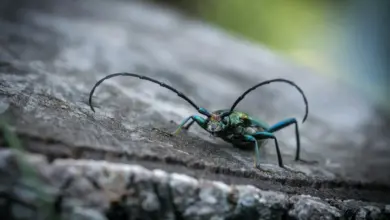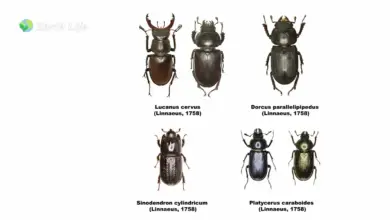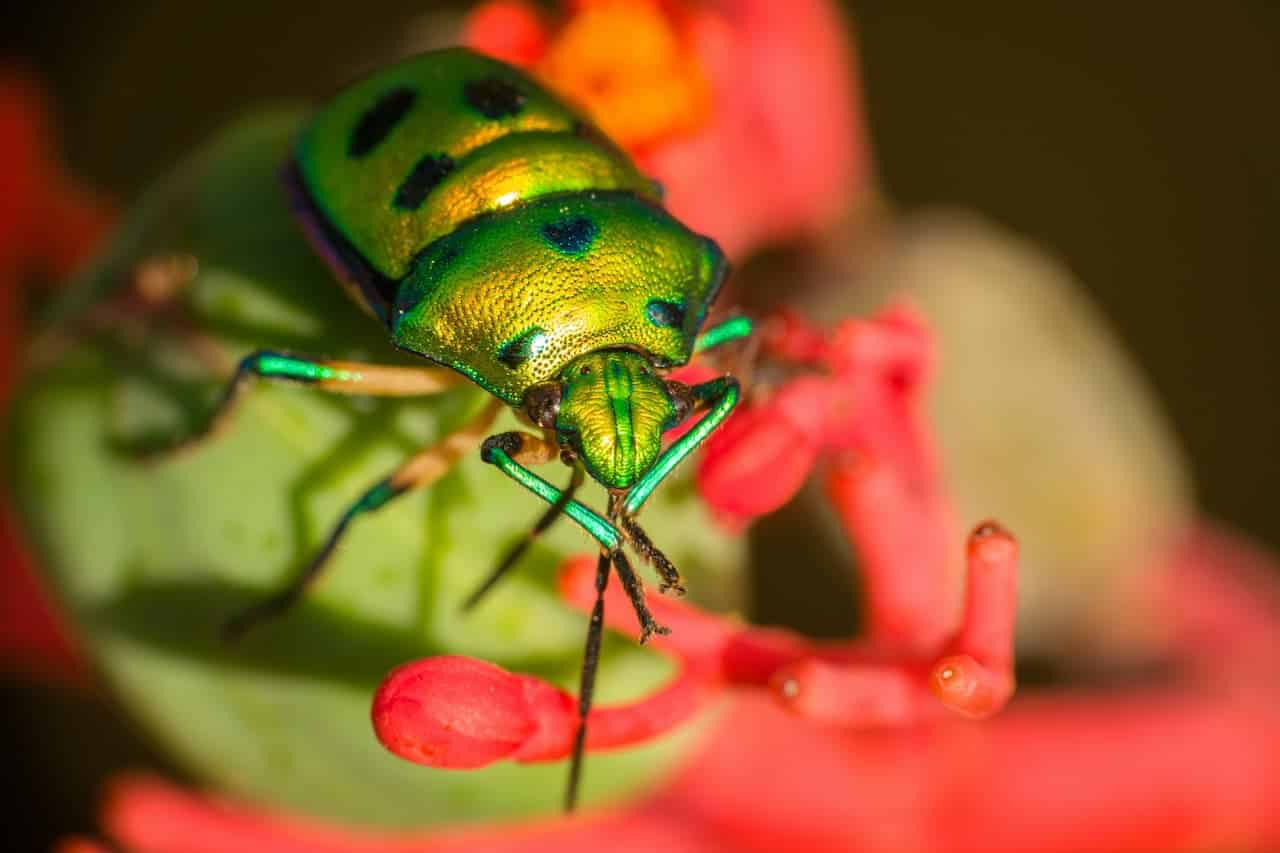Among nature’s vast diversity of beetle species, few capture our imagination as dramatically as the bombardier beetle. These small predatory insects have evolved one of the most fantastical and ingenious defense mechanisms – the ability to fire a scorching hot, noxious chemical spray from their abdomens when threatened.

Using muscular control, bombardier beetles can aim this explosive spray with startling accuracy directly at predators, startling them away.
The bombardier beetle’s firing system involves complex chemistry and intricate anatomical adaptations that scientists still strive to unravel fully. Their unique biology provides key insights into how evolutionary forces can shape intricate structures and behaviors over time.
Bombardier beetles also showcase nature’s most masterful examples of defensive weaponry and aim. Let’s explore how the bombardier beetle produces this potent chemical weaponry and wields it with such precision.
Classification and Identification
The bombardier beetles taxonomically belong to the large Carabidae family of ground beetles. Within this diverse family, they are classified into four specific tribes – Brachinini, Paussini, Ozaenini, and Metriini – based on anatomical traits and glandular features unique to these beetles compared to other ground beetles. There are over 500 identified species of true bombardier beetles globally that fall into these characteristic tribes.
Some of the most well-studied species include the European bombardier beetle, exploding bombardier beetle, popping bombardier beetle, and crackling bombardier beetle. Bombardier beetles are typically small in size, ranging from 12-25 mm in body length. They tend to have rounded or elongated body shapes with long, slender legs and prominent femurs adapted for speed.
Their coloration consists of dark blacks, browns, and reddish oranges, often decorated with dots, stripes, or patterns on the hardened wing covers. The beetles’ defining feature is their ability to spray hot, noxious chemicals from their abdomens when threatened, made possible by their specialized defensive glands.

Habitat and Geographical Distribution
Bombardier beetles inhabit a wide diversity of terrestrial habitats around the world, unified by their ground-dwelling lifestyle.
They are predominantly found in forests, grasslands, shrub lands, where they can blend into the leaf litter background with their camouflaging colors. Unlike many insects, they avoid extremely cold or dry desert regions.
In North America, bombardier beetles are distributed across the United States and Canada in areas with moderate seasonal temperatures and often burrow into soil or moss beds.
Across Europe, they are widespread in the woodlands and heaths of Western Europe but also occur in parts of Central Europe, typically preferring sandy soil environments.
In Asia, bombardier beetles occupy broad leaf and coniferous forests as well as shrub lands from Turkey through Russia, China, Korea and Japan. African species mostly frequent the sub-Saharan savanna and grassland habitats, with a handful of species in suitable North African environments.
South America harbors diverse bombardier beetles across its tropical and subtropical Central and South American ecosystems. Their wide habitat flexibility allows bombardier beetles to thrive on most continents apart from polar, alpine and arid desert regions.
Diet and Feeding
Possessing strong mandibles and aggressive predatory habits, bombardier beetles consume a diverse array of invertebrate prey. They are generalist predators, not specialized to feed on just one type of prey. Their diet includes insects like caterpillars, fly and bee larvae, and ants, as well as other arthropods such as centipedes, spiders, earthworms, slugs and snails.
Bombardier beetles detect prey via sensitive chemical receptors on their antennae that pick up odor molecules from the surrounding air or soil. Once prey is located, they rapidly charge at the target, overpowering it with their biting mandibles and sharp jaws.
Vigorous chewing injures or paralyses the prey. Digestive enzymes injected at the bite site help pre-digest and liquefy the prey’s tissues for easy external consumption. Although only medium-sized insects, bombardier beetles can take down relatively giant prey compared to their own body size.
Their spread spectrum diet, coupled with lightning speed and potent chemical weaponry, allows them to subdue dangerous prey like spiders, scorpions and centipedes.
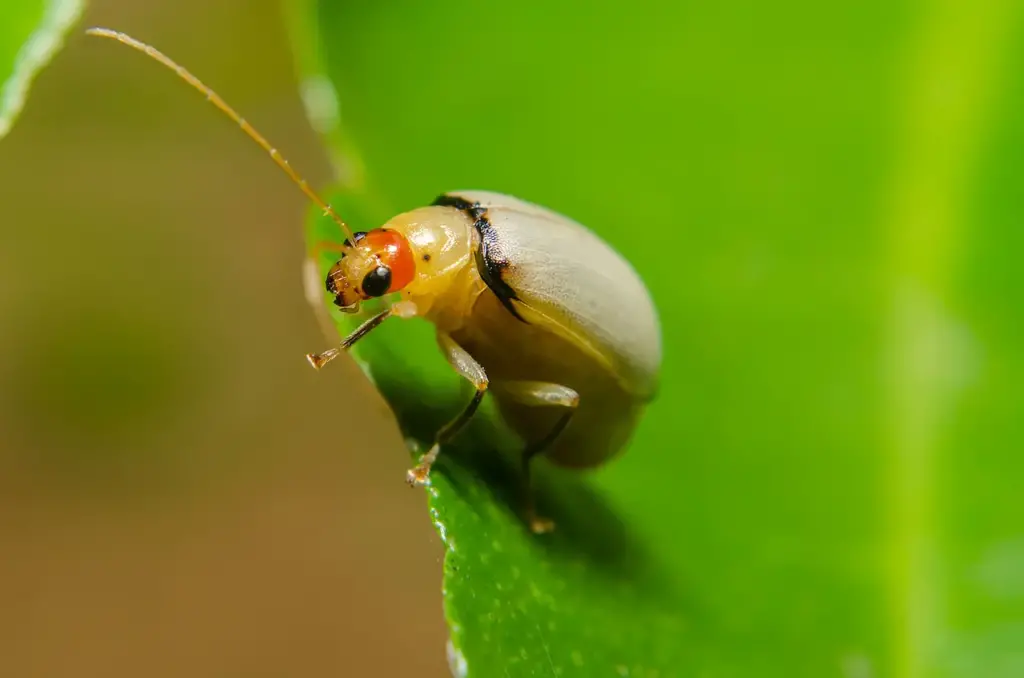
Anatomy and Physiology
Bombardier beetles have a typical insect anatomy but possess additional special glands and structures related to their defensive spray mechanism.
Head
The head has a pair of large compound eyes, mouth parts, and long threadlike antennae. The antennae are important sensory organs, detecting chemical signals that help locate prey.
Thorax
The thorax bears three pairs of walking legs. The legs are slender, with prominent femurs adapted for running and grabbing prey.
Abdomen
The abdomen houses the two chambers of the defensive gland system along with the associated muscles for expelling the spray.
Wing Covers
The hardened wing covers (elytra) protect the delicate hind wings underneath and meet in a straight line down the back. They provide a sturdy shield against attacks.
Defense Glands
Two defensive glands in the abdomen produce and store the chemicals for the spray. When threatened, muscles around the glands contract to eject the spray with great force.
Let’s look closer at the bombardier beetle’s incredible defense glands and chemistry.
Defense Glands and Chemistry
Bombardier beetles possess two glands in their abdomen – the reservoir chamber and reaction chamber – that produce and store defensive spray chemicals. When threatened, they mix and eject these chemicals with immense force and precision.
Reservoir Chamber
This gland contains enzymes that produce hydroquinones and hydrogen peroxide, which are stored in the chamber.
Hydroquinones are phenolic compounds made from the amino acid tyrosine. The enzyme produces and concentrates hydroquinones to very high levels in the reservoir.
Reaction Chamber
The second chamber houses substrate enzymes that catalyze an explosive chemical reaction when mixed with the contents of the first chamber.
Explosive Reaction
When threatened, the beetle moves muscles to open ducts between the two chambers. The hydroquinones and hydrogen peroxide in the reservoir mix and react violently with the enzymes in the reaction chamber.
This rapid reaction produces gas and heat. The boiling, noxious spray bursts out of the beetle’s abdomen tip with a loud popping sound.
The spray is ejected at 100°C and can travel 20-30 cm. It contains irritating benzoquinones that repel attackers. Even a human hand hit by the spray recoils instantly in pain.
Aiming the Spray
Bombardier beetles can rotate their abdomens 270° to precisely aim the explosive spray at predators. They eject pulses of spray in quick bursts, re-aiming between each one.
This incredible defense mechanism is energy-intensive for the beetles. After discharging their glands, they require 1-2 days to fully recharge their chemical ammunition.
Predator Defense in Action
When threatened by predators like frogs, spiders, or lizards, bombardier beetles deploy their explosive defensive spray with impressive coordination and marksmanship:
Predator Approaches
The beetle first turns its back and lifts its abdomen, pointing it towards the threat. The swollen tip acts as the nozzle.
Taking Aim
It rotates its abdomen, aligning the nozzle for a direct hit on the predator’s face, eyes, or body. The closer, the better.
Shooting Bursts
With good aim guaranteed, the beetle forcefully contracts its abdominal muscles, blasting the burning spray at the threat. Repeated pulse bursts keep the startled predator at bay.
Ready to Fire Again
If the target persists, the beetle swiftly re-positions its abdomen nozzle towards the advancing threat, firing off more sprays if needed to teach the predator a lesson.
Withdrawing
Once the attacker retreats, the beetle can quickly hide under leaf litter or soil. Its camouflage makes it disappear against the background.
Recharge Time
After deploying its chemical arsenal, the beetle will seek safety while it takes 1-2 days to fully replenish its explosive reservoirs before becoming battle-ready again.
So, the combination of potent chemistry and precise spray-aiming enables the bombardier beetle to deter much larger predators despite its small size.
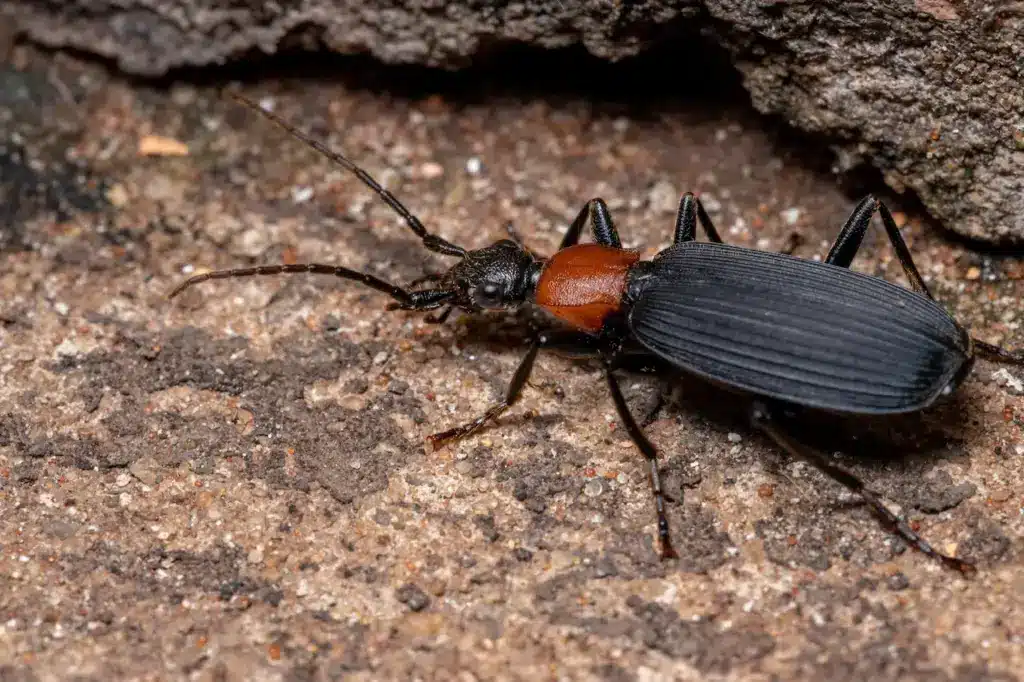
Evolution of the Bombardier Defense System
Bombardier beetles could not always create explosive defensive sprays from specialized glands. This capability evolved gradually over millions of years through a series of adaptations:
Step 1: Chemical Defenses
Early beetle ancestors used simple poison or venom bites to try and deter predators. This laid the foundations for a chemistry-based defense.
Step 2: Warning Coloration
Body colors evolved that loudly advertise the beetle’s toxicity – an aposematic strategy still used by modern bombardier beetles. Predators learn to associate the patterns and colors with nasty spray retaliation.
Step 3: Specialized Glands
Glands developed devoted to producing higher volumes of defensive chemicals like hydroquinones. This allowed the toxic secretions to be stored under pressure, ready for discharge.
Step 4: Muscle Control
Muscles surrounding the glands acquired finer neurological control. This enabled the beetle to precisely target the direction of spray release.
Step 5: Separate Chambers
The glandular system evolved separate reservoirs for the different precursor chemicals. This segregation prevents them from reacting prematurely inside the beetle.
Step 6: High Pressure System
Finally, valves and ducts were developed to allow the beetle to explosively mix the isolated precursors at will to create the characteristic popping spray.
Many small incremental changes over geological time thus built up the perfectly coordinated defense strategy used by modern bombardier beetles.
Mimicry of Bombardier Beetles
Several harmless beetle species have evolved clever physical mimicry to fool predators into thinking they are bombardier beetles. By copying the bombardier’s appearance, mimics gain protection from predators that want to avoid a nasty explosive spray.
Some bombardier beetle mimics include:
False Bombardier Beetles
These non-bombardier carabid beetles resemble true bombardier beetles very closely in size, shape and coloration. They fool predators into thinking they, too, can spray boiling chemicals.
Bombardier Beetle Wasps
Certain parasitic wasps like Thyreopus wasps have striking black and orange patterns mimicking the bombardier’s ‘warning colors’. This advertises falsely that they sting like the beetle’s spray.
Bombardier Bee Mimics
Tropical bee species such as Pseudodynerus have black and red bands that make them look just like bombardier beetles. The mimicry helps them avoid predators.
Mimics benefit from bombardier beetles’ formidable reputation, allowing them to thrive using just pretense and bluffing rather than investing metabolic energy into chemical defenses.
Impacts of Bombardier Beetle Spray on Humans
Bombardier spray is not particularly toxic to humans if just a small amount of spray briefly contacts the skin. However, larger exposure can cause noteworthy irritation and pain:
Skin Contact
A direct hit by the boiling benzoquinone spray causes immediate burning pain and reddening of the skin. Blisters may form with more prolonged contact.
Eye Contact
Spraying to the eyes results in burning, tearing, and temporary blindness. But eyes recover after flushing with water. No permanent eye damage.
Respiratory Irritation
Inhaling large amounts of vaporized secretions can irritate the nose and respiratory tract, causing coughing, choking, and discomfort.
Allergic Reactions
Some people may develop a localized rash, itching, and swelling from contact with the spray. Allergies to quinone chemicals are uncommon, though.
While an irritant, the beetle’s defense spray is not potent enough to cause severe toxicity or lasting damage. The momentary pain teaches larger animals not to mess with the beetle!
Conservation Status and Threats
Most bombardier beetle species are currently not considered threatened or endangered. Their wide distribution and adaptability to diverse habitats have prevented major population declines so far. However, certain risks can impact local bombardier populations:
Habitat Loss
Deforestation, urbanization, and land conversions can reduce suitable habitat areas for bombardier beetles. Some species are more sensitive to habitat changes.
Agricultural Pesticides
Runoff of chemicals and fertilizers from farms can leach into their forest and grassland habitats. Carabid beetles are vulnerable to pesticide accumulations.
Invasive Species
Introduced predatory ants, reptiles, and amphibians can reduce native bombardier numbers on islands and isolated habitats.
Climate Change
Global warming may cause the drying out of moist habitats favored by some bombardier species. Hotter temperatures also impact their prey populations.
Targeted conservation planning and habitat protection can help mitigate habitat loss and climate change impacts on susceptible bombardier beetle species in the future.
Predation on Bombardier Beetles
While bombardier beetles are well defended against many predators, they are still preyed upon by certain animals that have adapted resistance or immunity to their fiery spray:
Bombardier beetle larvae lack the mature glandular defense systems of adults. They are more vulnerable to predation by ants, wasps, ground beetles and spiders. Quickly developing their spray apparatus is crucial for survival after hatching.
Some frog and toad species seem impervious to the irritating benzoquinones, likely due to mucus barriers and toxins in their own skin. They readily consume both larval and adult bombardier beetles.
Poisonous Snakes like the garter snake have evolved resistance to the burning spray and prey on the beetles in spite of their defenses. Thick scales protect the snake’s eyes and skin from irritation.
Raptors like hawks and owls are aggressive predators of adult bombardier beetles, able to snatch them before spray can be deployed. Their powerful beaks rip through the hard-wing covers.
So, while bombardier beetles have very effective defenses against most predators, they must still contend with some specialised enemies equipped to penetrate their toxic arsenal.
Commercial Uses and Biomimicry
Beyond inspiring scientific fascination, the unique biochemical firing mechanism of bombardier beetles has been studied for potential engineering and commercial applications:
Researchers have developed micro-machines inspired by the beetle’s combustion method for fuel ignition and propulsion systems. Miniature beetle-like devices use controlled explosive sprays for thrust and power generation.
Its two-part chemical reactor has been mimicked to design safe, portable biomedical drug preparation systems where reactive precursors are mixed immediately before use.
Studying the beetle’s finely tuned muscular control and spray direction has advanced designs for precision aiming mechanisms in cameras, telescopes and firearms.
The bombardier beetle’s ability to withstand the heat and pressure of its own internal explosions contributes to materials science research on blast-resistant surfaces.
By emulating the beetle’s natural engineering, innovators continue to find new ways to harness and apply these biological design principles to human engineering challenges. The tiny beetle holds far-reaching inspiration.
Conclusion
The bombardier beetle presents a standout example of an insect that has evolved an elaborate defensive tactic specially tailored to its ground-dwelling predatory lifestyle. The bombardier’s powerful chemical spray deters predators many times larger than itself, enabling it to thrive in habitats around the world.
Yet it accomplishes this through an intricate gland system requiring timed coordination between chemicals, muscles, and precise anatomical aim. Each bombardier beetle is a tiny chemist-marksman rolled into one.
While their defensive secretions can cause temporary pain, the bombardier poses no serious threat to humans. Protecting their native habitat environments is the major conservation priority. Understanding how evolutionary forces can shape impressive anatomical novelties will continue to motivate scientists to uncover the secrets of the bombardier beetle’s ingenious defenses.
These insects have carved out an important defensive niche in nature through millions of years of gradual adaptations. The tiny bombardier beetle reminds us never to underestimate the impressive survival strategies of even the smallest beings in an ecosystem.


